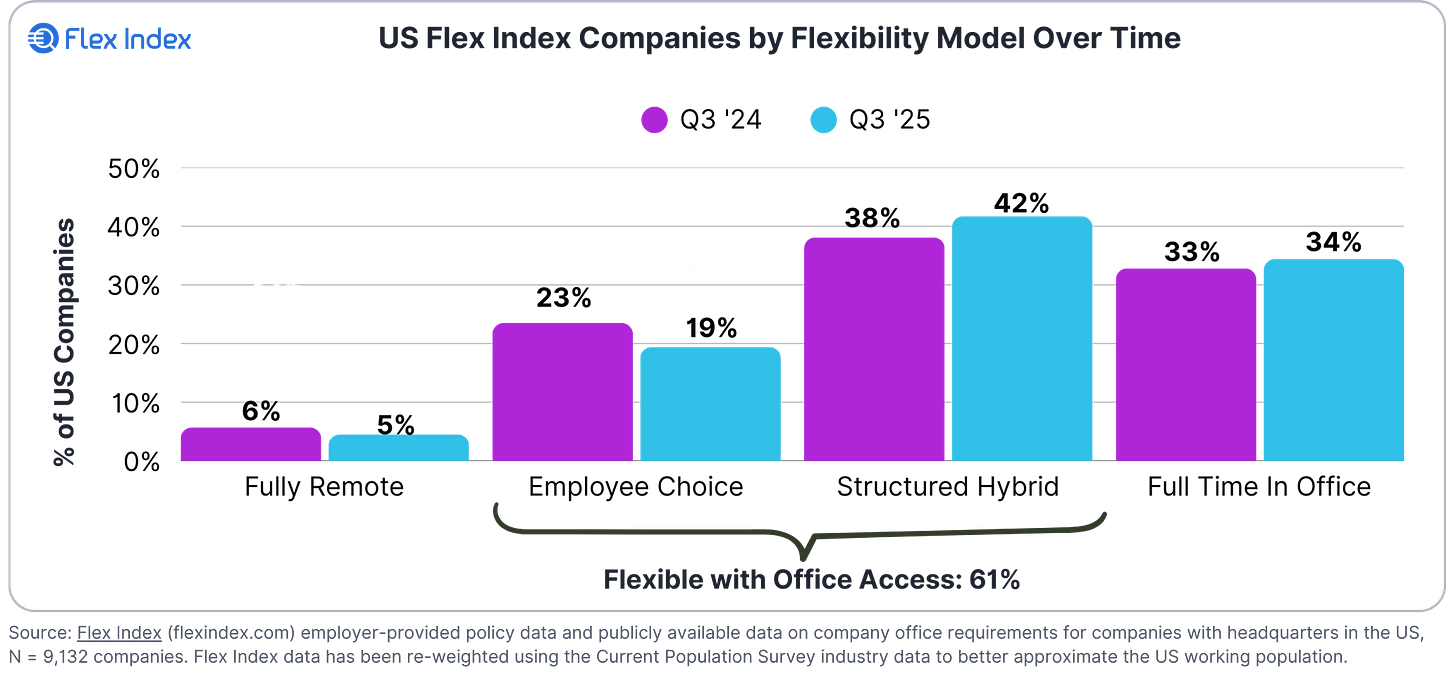Is Return to Office Still Stalling?
Plus, why flexibility continues to win in the commercial real estate market
👋 Happy Tuesday! Did Microsoft screw it up or get it right when it comes to RTO? The changes on the surface might seem modest — changing from 50% in person guidance to a 3 day a week “expectation” — but that doesn’t change the fact that many employees are being impacted. Microsoft took a data-driven approach: will their multi-year examination of what it takes for teams to thrive pay off? Read on and tell us what you think!
In this week’s edition:
👀 Return to Office is (Still) Stalling
📊 Flexibility and Office Access
☀️ August Lull in Office Traffic
Current Subscribers: 10,335
Please forward to colleagues and friends!
THIS WEEK’S FLEX FOCUS 🔍
Return to Office is (Still) Stalling
The Wall Street Journal tapped our Q3 Flex Report to dig into why office attendance still lags while return-to-office demands crank up — they even produced a pretty nice-looking graphic of our data!
The core of the gap: managers under pressure to deliver are unlikely to fire employees who perform but don’t check an attendance box. As Beth Steinberg put it “There’s a lot more pressing things for companies to be worrying about right now. I haven’t heard of many consequences for [no shows], especially if somebody’s a high-performer.”
The fact that many big companies are using RTO demands to drive up attrition is becoming more widely proven. In its August economic update, the Federal Reserve observed that some employers were “reducing head counts through attrition—encouraged, at times, by return-to-office policies.”
But Stanford’s Nick Bloom gets at the challenge: “It is a cheap way to reduce head count, there’s no disguising that. The problem is, you don’t get to choose who leaves.”
FLEX WORK QUICK HITS 💥
Stay ahead of the curve with our curated roundup of the trending flexible work stories making waves right now. Here's what you need to know 👇
Business Insider: AT&T tracked employee attendance to find “freeloaders.” Now, it admits the system is creating anxiety and driving workers to the “brink of frustration.” Adding injury to insult: it’s also inaccurate.
MIT Sloan Management Review: Tough-talking CEOs might impress Wall Street, but data shows that human-centered leadership wins. In this interview, Flex Index publisher Brian Elliott examines why command-and-control tactics fail at AI adoption, RTO mandates, and performance management.
Fortune: Scientists confirm that WFH makes people happier, less stress, better rested and at least as productive. Productivity, motivation and wellbeing all improved when remote work was a personal choice, rather than a mandated one.
STAT OF THE WEEK 📈
Flexibility with Access to Shared Space
The most stable aspect of workplace policies over the past few years may be that 61% of firms pursue flexible solutions while providing employees access to offices.
Most people think “hybrid” when they talk about flexibility and office access. But Employee Choice models — where there’s no single company or function-level policy — also provide access to spaces for team collaboration and individuals who need it.
That overall stability is a key reason why the commercial real estate market continues to move towards more flexible solutions.
FLEXPERT INSIGHTS 🧠
Will the Tide Turn Post-Labor Day?
Back in July, there was a lot of coverage of Placer.ai’s report that office traffic (measured by mobile phone usage in office buildings) spiked by 7.6% over the prior year. But August brought an equally quick retreat, no doubt in part driven by summer holidays.
How much the gap narrow as the job market continues to get weaker this fall?






